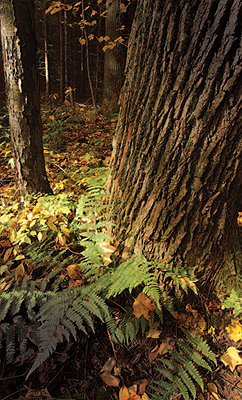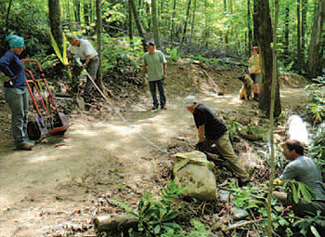Sustaining Bear Run Nature Reserve’s Forest
Each year, thousands of visitors of all ages experience the Western Pennsylvania Conservancy’s 5,027-acre Bear Run Nature Reserve, which is the setting for Fallingwater. Located on the western flank of Laurel Hill in the Laurel Highlands, the lush reserve offers hiking trails, backcountry campsites and hunting and fishing opportunities.

Interior forest, Bear Run Nature Reserve
Photo by: Greg Funka
However, the nature-lovers who trek along the 20 miles of trail that wind through the reserve encounter a forest that is quite different from the one traversed by Shawnee and other Native American tribes, and even the one described by early 20th century botanists. In addition to the years of tree removal and ground disturbance from mining, logging and farming that began more than a century ago, significant factors including blight, invasive species and other impacts also have affected these forests. These impacts have affected the types and sizes of trees, diversity of animal and plant species, soil composition and other aspects of the forest.
To address forest management needs, the Conservancy is implementing a comprehensive multiyear plan to restore Bear Run Nature Reserve’s forest to more natural conditions. Referred to as a “legacy forest,” it includes characteristics of old-growth forest, such as diverse tree age, size and physical structure and other ecological aspects. The Conservancy’s goal is to restore Bear Run Nature Reserve to a level of biological richness and ecological stability that will serve as a reference point and keystone of ecological integrity in the Laurel Highlands.
One phase of the management plan was implemented in 2008, when WPC, under an agreement with the USDA’s Natural Resources Conservation Service, began to restore several former agricultural fields to native forest. This included planting warm-season grasses, wildflowers, shrubs and trees. A good place to see the results of this planting is on the east side of Rt. 381, about two miles north of the Fallingwater entrance. A sloping wet field now has young trees growing out of the tops of planting tubes. The tubes provide the ideal micro-climate for seedlings, and protect against animal browsing.

WPC staff, volunteers and paid contractors maneuvered large rocks as part of a trail restoration project.
Visitors to the reserve will be able to continue to see firsthand how this forest work is progressing. The Conservancy conducted a complete assessment of the reserve’s 17 trails and developed a trail improvement plan geared toward improving the health of the forest and other natural resources, providing a more intimate experience with the surrounding forest, and sustainable management of the forest and trails by WPC staff and volunteers.
Over the last two years, staff, volunteers, and paid contractors have been implementing the trail improvement plan. The monthly workdays of the dedicated stewardship volunteers are currently devoted to digging rerouted trail areas, maneuvering large rocks to allow for the new locations, and other trail enhancement tasks. This phase of the project, which is charted to be completed by fall of 2013, is aimed at improving eight miles of the reserve’s trails. Other future enhancements will be implemented as funds are available.
The Bear Run Forest Past and Present
When Pittsburgh department store magnate Edgar Kaufmann and his family first came to Bear Run in 1916, nearly all of the land had been timbered—largely for railway ties and mine posts. To help prevent contamination of the watershed and offer protection to the forests, they began acquiring more land, only to have the area besieged by the chestnut blight of the 1920s. By 1933, the Kaufmanns committed to a comprehensive plan of conservation that was implemented in the succeeding decades.
The Conservancy first became stewards of Bear Run property in 1963, when Edgar Kaufmann, jr. donated Fallingwater and 469 surrounding acres to WPC. Between 1964 and 1991, the Conservancy acquired 1,513 additional acres from the Kaufmann family or estate. WPC has also obtained more than 3,000 acres from other owners over the years, most recently purchasing a 25-acre parcel located along the steep slopes leading to Bear Run in 2010.
Thanks to years of protection and regrowth, the reserve’s forest is healthier today than when the Kaufmanns first arrived. However, the Conservancy continues to address challenges, including impacts from the gypsy moth and other invasive exotic plant and animal species, the loss of top predators such as wolves and mountain lions, the overabundance of some native plant and animal species, and the loss or disruption of historical ecological processes such as fire.
As a result, forest trees are smaller and the composition of plant and animal species is significantly altered from the original, pre-European, forest. Characteristic native species, such as the American chestnut, are reduced or absent. Red maple is tending to replace oak species in the forest canopy—a trend documented throughout the Appalachians. The groundcover or herbaceous layer has been weakened and reduced and forest soils have been altered.
Two invasive species are current targets of management on the reserve. The hemlock wooly adelgid, an exotic aphid-like insect that defoliates and kills eastern hemlock trees, was first discovered in Ohiopyle State Park in 2009. In response, WPC began a monitoring program to track the specie’s presence on the reserve. Hemlock stands cover approximately 120 acres, primarily in a narrow corridor along Bear Run. The loss of hemlock as a primary component of the forest could have a permanent adverse impact on habitat quality and species diversity.
Unfortunately, by spring 2012, hemlock wooly adelgid was confirmed throughout the reserve. Currently, the only effective and reasonable approach to controlling the adelgid is through single-tree treatment using a chemical insecticide. More than 70 infested trees within the limited forest area immediately surrounding Fallingwater were treated earlier this year. An initial follow-up indicated promising results.
Japanese stiltgrass is an exotic grass that can quickly outcompete native herbaceous vegetation. Over the last two years, infestations of stiltgrass have been chemically treated along Rt. 381 and on some of the primary trails. This work is part of a regional collaboration that includes WPC, Fort Necessity National Battlefield, Ohiopyle State Park, the PA Bureau of Forestry, the Fayette County Conservation District, New Meadow Run Community, and the U.S. Forest Service.
The Western Pennsylvania Conservancy is fortunate to be able to own and manage this reserve, and will continue to actively steward the reserve as a natural treasure important for its natural resources and as an expansive natural setting for Fallingwater.
Efforts to reestablish American chestnut tree highlighted at Bear Run
Once described as the most common tree in Pennsylvania, the American chestnut
provided a bountiful supply of nuts for Native Americans as well as wildlife including
deer, elk, bear, turkey and grouse...
<read more
